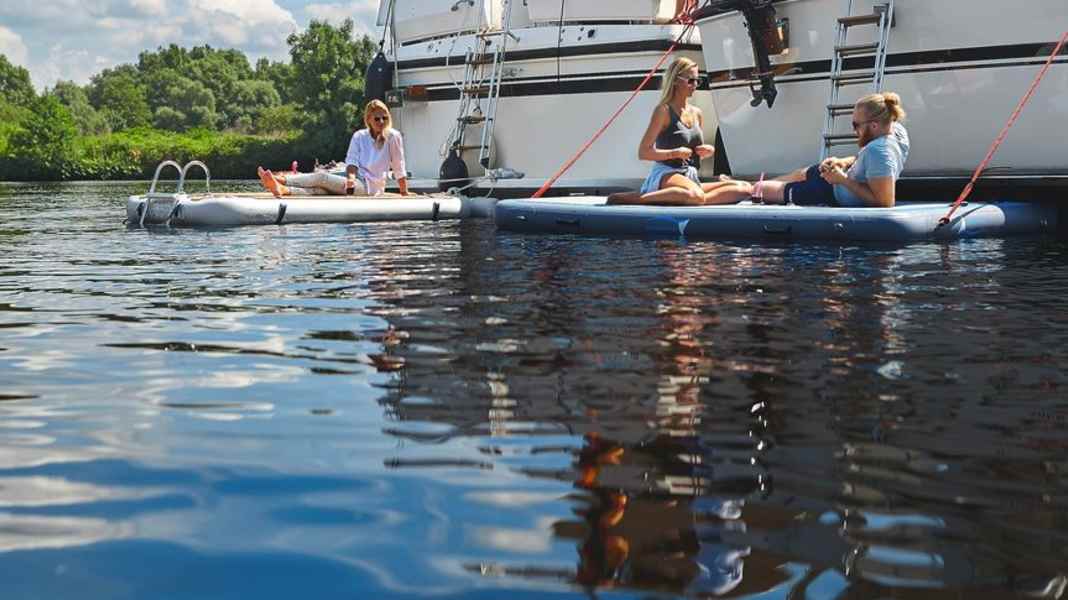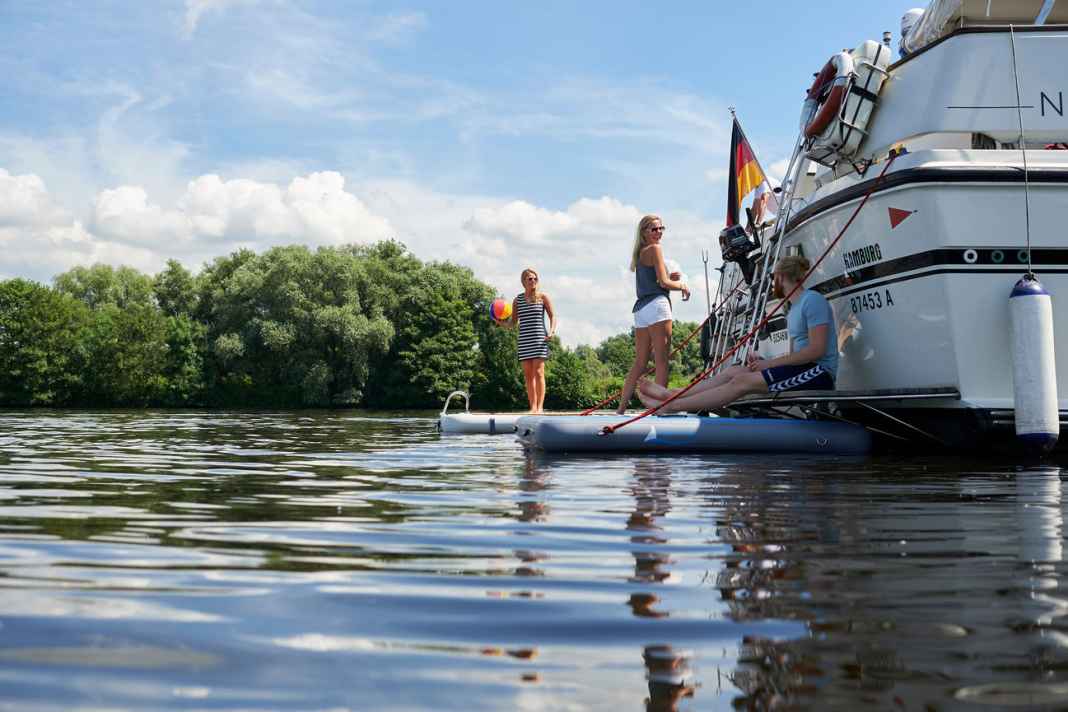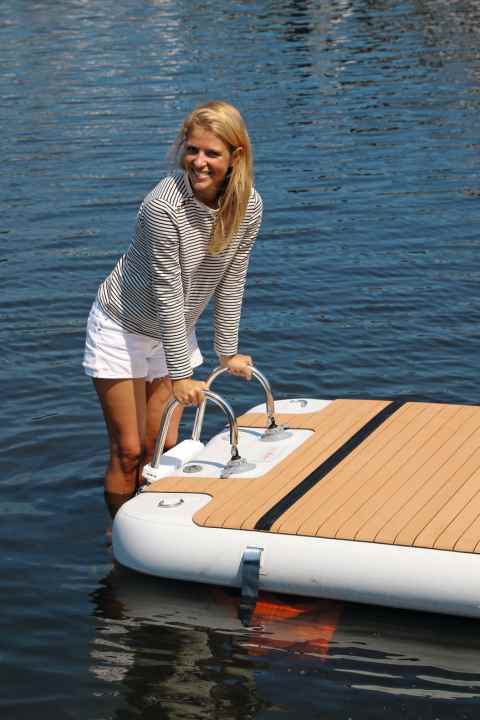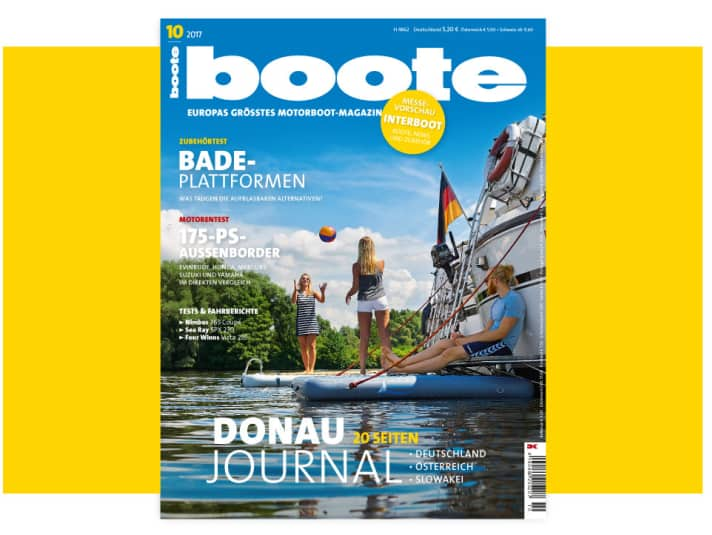
Owners of modern motor yachts have it good. Depending on the size of the boat, they have more or less comfortable bathing platforms integrated into the hull shape, on which it is possible to relax in the sun.sit, relax or even dine exquisitely leaves.
Anyone travelling on older or smaller boats can hardly resist the odd envious glance. The dilemma becomes particularly clear in the bay.
While some people set up tables, chairs and sun loungers on the boat's own water terrace, others are lucky if there is enough space at the stern for a conventional seat cushion.
The accessories industry has been offering a remedy for some time now. We are talking about so-called inflatable bathing or swimming platforms. The biggest advantage of these platforms is their comparatively low weight of around 20 kg and the fact that they can beSimply roll up when not in use and stowed away.






This means that even a6 m boat with a 2 m x 1 m bathing platform and if you own a 40-foot boat, you can easily attach a 6 m2 "living area" including air furniture to the stern.
If you look in the catalogues or on the providers' websites, you will quickly notice enormous price differences. We wanted to find out how the various models differ, how stable they are in the water and whether the huge price differences are justified. For the test, we had the seven most important models delivered to us and examined them both on land and on the water.
Sizes and weights
The dimensions of our test candidates vary between the approximately 2.5 m2 of the small Renrib platform and the impressive 8.75 m2 of the large Renrib model. All the others are somewhere in between. If we take the price as a yardstick, A.W. Niemeyer's Aqua Marina platform offers by far the lowest price per square metre at around 100 euros/m2.
At the other end of the price scale is the Nautibuoy platform at a whopping 1256 euros/m2. The weight also varies according to the size.
The small Renrib weighs in at 12 kg, making it almost manageable, while the heaviest and largest platform, the large Renrib model, is better carried by two people as it weighs around 40 kg. As a general rule, two people are usually needed on board anyway to set up the platforms and attach them to the stern.
Structure and fastening
All models can be set up, i.e. inflating the platforms, in just a few minutes without any problems. However, it is important to have a powerful air pump that matches the required operating pressure of the platforms (follow the instructions). We liked the pumps supplied by Renskib and Nautibuoy the best.
Both manufacturers rely on a two-stage pump that creates a lot of volume in the first stage and generates the necessary pressure in the second stage. The same manufacturers also equip their platforms with pressure relief valves so that excess air can escape without damaging the bathing platform - a safety feature.
We were less pleased with the pump from Offshore Tools. It was too weak for the product, so after 20 minutes of pumping we used a different pump to get the necessary pressure onto the platform.
Appropriate eyelets, handles or cleats are needed to reliably attach the bathing platforms to the boat using lines. Here, all candidates had to measure themselves against the Renrib platforms designed for professional use.

Both versions come with solid plastic cleats and additional metal eyelets. The companies Nautibuoy and Offshore Tools solved this problem similarly well. Here we also found sufficiently dimensioned and sensibly placed eyelets. The attachment options at Aqua Marina and Aquaglide are also completely adequate for recreational use.
Slip resistance
Just like integrated bathing platforms, the inflatable versions must also be non-slip in order to prevent unintentional overboarding. There were big differences here. Nautibuoy, Renrib and Offshore Tools all demonstrated very good slip resistance. All four models were safe to walk on barefoot in both wet and dry conditions.
In purely visual terms, the Nautibuoy platform clearly stands out from the competition in this criterion. With its imitation teak covering, it was the front runner not only technically, but also in terms of design. The Aqua Marina and Aquaglide platforms only offer limited slip resistance when wet, but are easy to walk on when dry.
Stability in water
Let's move on to what we consider to be the most important purchase criterion for a floating bathing platform. How stable it is in the water ultimately determines what it is suitable for and whether it can only be used as a better air mattress or as a fully-fledged boat extension.
The buoyancy stability is decisively influenced by the material used, the thickness of the platform (freeboard), its size and additional stabilisers.

We found the best combination of these factors in the Nautibuoy Sport Teak. In addition to the great height of 24 cm, it has four firmly connected water bags, as known from life rafts, which fill up immediately after the first contact with water and keep the platform stable in place. Even headstands or similar sporting activities could not cause it to sway.
The large Renrib platform with a freeboard height of 20 cm was similarly stable in the water. It was developed for professional exterior cleaning on yachts and offers very good stability due to its sheer size of just under 9 m2 , which is further enhanced by an additional air keel on the underside.
Third place is shared by the small Renrib platform and the Offshore Tools product. Both are safe to walk on, although the latter offers more freedom of movement due to its more than twice as large surface area.
The cheapest model in the test, the Aqua Marina, also performed surprisingly well. With a height of 15 cm and a base area of just under 4 m2, it sits satisfactorily in the water, but without achieving the stability of the aforementioned platforms.
With a thickness of only around 12 cm and without additional stabilisers, the Aquaglide products could not keep up in this test point. Compared to the other products, their floating stability can only be rated as "moderate". In addition, the lower freeboard means that water quickly reaches the surface when people step onto the edges of the platform.
Conclusion
At the beginning of our test, we asked how the large price differences can be explained and whether good inflatable bathing platforms always have to be expensive. We can answer the second question with a clear no.
On the other hand, from a purely technical point of view, the most expensive boats in our test are also the best. For around 4700 euros, Nautibuoy offers a technically and visually sophisticated product that every owner will enjoy. Second place goes to the professional platforms from Renrib.
They are also technically sophisticated and designed for the highest demands, especially as work platforms. However, with prices per square metre of between 400 and 500 euros, this service also has to be paid for.
Our price-performance winner is clearly the Offshore Tools platform. It is just as stable in the water as the Renrib models and, with its 6 m2 surface area, is suitable for four people, but only costs around 1000 euros. The Aqua Marina product is recommended for quick swimming trips with small boats. At 400 euros, it is unbeatable value for money and offers enough space and utility for two people.


